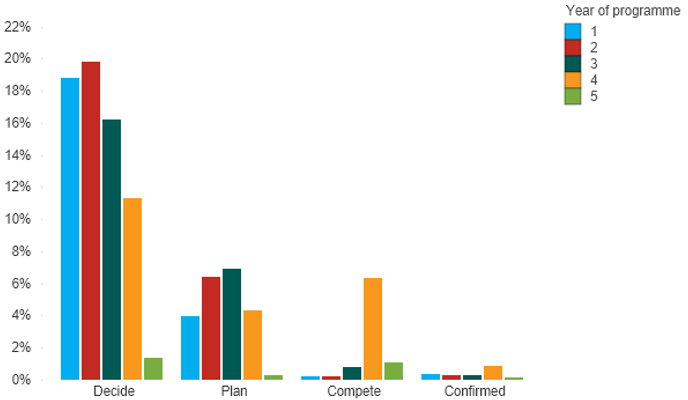What does a Careers Centre website need?
The Digital Communications team started a redesign of the Careers Centre website in January 2021. The first phase of this project aimed to find out what users needed from the Careers Centre. To this end, we carried out the following activities:
- Competitor analysis
- Social media review
- Website survey
- Stakeholder interviews
- Website analytics
- Analysis of matriculation survey
From this research we have been able to formulate a new information architecture, which is currently in a draft phase.
Competitor analysis
This competitor analysis was conducted to review other careers services websites at other notable UK universities to compare how their sites feel and function. Other career websites were also reviewed to assess how innovative they are and if we can adopt any similar functionality.
Most university websites reviewed followed a similar structure:
- breakdown of user audience
- navigation to what information audiences require at their stages of career applications
- breakdown of industry sectors and some information related to fields within those sectors
- a careers service portal built on a third-party application.
Sites that performed favourably were those with reduced text content. There was more focus on providing direct answers to users rather than heavily detailing a lot of superfluous information.
A lot of sites also directed to their careers portals from branches within the website – from booking appointments to finding available positions.
Ultimately, the current St Andrews careers website is built similarly to other university careers services websites. The main areas to focus on to increase user satisfaction will be:
- clear and concise text content
- consolidated pages to combine scattered content
- early referral to CareerConnect platform
- clear user audience paths.
Careers Centre social media review
The Careers Centre has official accounts on Facebook, Twitter and Instagram. They also post to SaintConnect which is an internal social media platform. Their current social media audience size (excluding SaintConnect) is around 7,300 profiles.
Their social media channels are promoted on the Careers Center website with links to Facebook, Twitter and SaintConnect in the website footer. However, there is no link to their Instagram account. On their contact page there is also a link to their Facebook account but no other accounts.
The Careers Centre is active on social media, with multiple posts on each account and sometimes they post multiple times on the same day. When content is shared it is duplicated across their various accounts and the content is not tailored to fit the dimensions of each platform.
The main issue for the Careers Centre is engagement. Despite posting regularly, engagement is low across all platforms with many posts receiving no engagement whatsoever.
However, this is an industry issue, Manchester and Cambridge have accounts of comparable sizes and have similar engagement levels. Even Prospects which has an audience size of over 76,000 profiles has similar engagement levels to St Andrews.
The Careers Centre should consider the following to improve their social media presence:
- Consider using LinkedIn features (perhaps instead of other channels)
- Ensure all content is optimised for each account
- Build engagement with other career focused accounts
- Reduce social media content and make sure all shared content is relevant and has a clear call to action.
Careers Centre website survey
The survey was conducted on Microsoft Forms and was live for 14 days from Monday 25 January to Sunday 7 February 2020. The survey was promoted online through the University website, social media, and newsletters and incentivised by offering three participants the chance to win a £25 Amazon gift voucher. There was a total of 25 questions in the survey, however, participants only saw questions relevant to them based on their previous answers.
There was a total of 1,071 survey respondents. 47% of which were current undergraduate students, making it the largest demographic group to respond. Second-year students responded more than any other year group providing 34% of total undergraduate responses. 9% of respondents were University alumni, 40% of whom graduated 1 to 2 years ago.
There were four main themes which were persistent throughout the results: navigation, design, content, technical issues. However, there was contradictory responses from respondents for each theme. For example, some respondents found the Careers Centre easy to navigate, liked the design and thought that there was useful career information. However, at the same time other respondents found the website difficult to navigate, believed that the current design was too bright, and the available career information needed to be updated and expanded on.
The reasons for these contradictory opinions are uncertain as this was not covered in the survey questions. It could be assigned to a variety of factors such as if users have a different option of the website depending on what device they use to view the website. The website is not optimised for mobile, and this was noted in the survey responses. If a user mainly accesses the site on a mobile device, they may have a lower opinion as it is not optimised for best use.
The main reasons for visiting the Careers Centre website generally resolved around jobs, in particular part-time jobs. There are slight differences in top tasks based on the different demographic groups, however for all groups, except alumni, the top task was to find a part-time local job.
Undergraduates
- Find a part-time local job
- Find internships and work experience
- Find a graduate job
Postgraduates
- Find a part-time local job
- Find a graduate job
- Find academic related part-time work for postgraduate students
Alumni
- Find a graduate job
- Find careers options related to your degree
- Find advice if you’re unsure about your career direction
Staff
- Find a part-time local job
- Find careers options related to your degree
- Find a graduate job (joint 2nd)
Prospective students
- Find a part-time local job
- Find a graduate job
- Create a CareerConnect account
Stakeholder interviews
The following stakeholders were interviewed to determine what they needed from the Careers Service. In total, 41 people were consulted.
- Careers advisers
- Careers CV advisers
- Careers opportunities team
- Careers administrators
- Undergraduate students (third and fourth year arts and sciences)
- Postgraduate students (taught and research)
- Employers
- Alumni
- Development
- OSDS
- CEED
They were asked a range of questions that aimed to discover the career related information they needed as part of their job or studies. The results of these workshops and interviews were summarised into over 150 ‘user stories’ and organised into different tasks and prioritised in collaboration with the Careers Centre. These tasks will be the main focus for creating the information architecture for the new website.
Analytics report
The analytics on page views validates the findings found in other research with close alignment with user top tasks and page popularity. The following table shows the top 10 pages on the main careers website from January to December 2020 (note that the pageviews are indicative as users have to opt-in to allow tracking cookies).
| URL | Pageviews | Unique pageviews | Time on page |
| Home page | 22864 | 15402 | 00:00:00 |
| CareerConnect | 7691 | 6589 | 00:03:33 |
| Jobs and work experience | 6608 | 4713 | 00:00:20 |
| Part-time jobs | 5642 | 4258 | 00:02:38 |
| Internships | 5527 | 3432 | 00:00:29 |
| Career options – political risk analysis/ | 5230 | 4078 | 00:04:03 |
| Graduate destinations | 4755 | 2787 | 00:03:07 |
| Career options A-Z | 4583 | 2879 | 00:00:40 |
| Career options – intelligence private sector/ | 4298 | 3142 | 00:03:38 |
| Careers advice | 4182 | 3241 | 00:02:51 |
The professional skills web pages that currently sit outside of the main careers’ website were also popular and the main landing page would be in ranked in 9th position if included in the above table.
Similarly pages with low numbers of page views include case studies, videos, Chinese FAQs, researchers, academics and employers. This may indicate a number of causes –
- Content that has a low level of importance.
- Content that is only relevant to a small number of users.
- Poor quality content that users will not return to.
- Technical issues with the web page.
Not all systems provided adequate analytics data with the Graduate Attributes web application not currently using Google Analytics, while Career Connect analytics only includes basic information on page views which doesn’t provide sufficient detail to identify user behaviour.
Hotjar was used to observe user behaviour on the existing website and confirms that the current design has some user experience (UX) issues that will be improved by using the digital pattern library and prioritising content on the page according to our research findings on top tasks.
Matriculation survey
As part of the matriculation process, students are required to answer a series of questions about their career plans. One of the questions asks ‘What stage are you at in your career planning? Please select the statement which best represents your current careers position’. The options vary from ‘I am not ready to start thinking about my career yet’ to ‘I have a job, further study, or my own business plan confirmed’. The responses are then categorised into planning phase:
- decide
- plan
- compete
- confirmed.
The results for the 2020 matriculation show that most students have not yet thought about their career, particularly for years 1 to 3. Therefore, information on the Careers website needs to particularly help students through this decision phase.
Conclusion
The research phase of the Careers Service redesign has been one of the most thorough we have undertaken. The Careers Service has a diverse array of stakeholders with complex needs. One of the challenges is going to be how to organise information that meets the needs of specific users (alumni, employers, undergraduates, postgraduates) while also taking into account the stage that a user is at in their career journey (decide, plan, complete, confirmed). The new website also needs to provide flexibility in the way information is organised and managed so that it is sustainable in the long term.
We look forward to working with the Careers Service to provide a solution that meets these demands!

